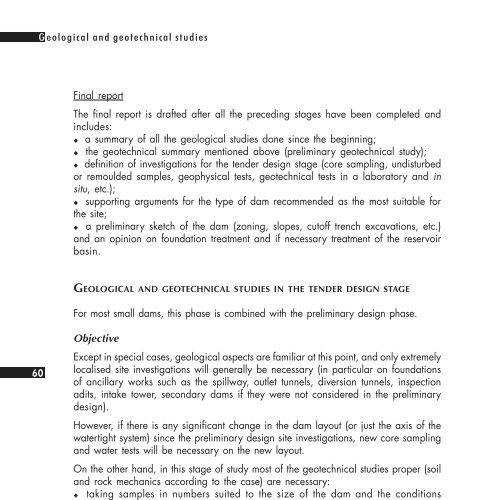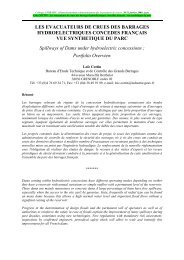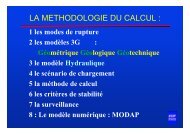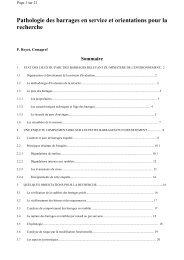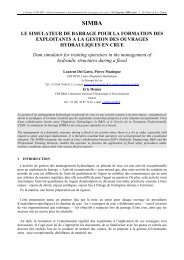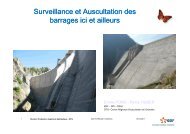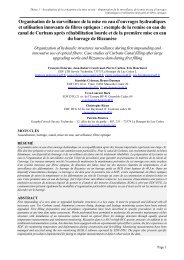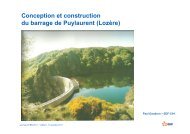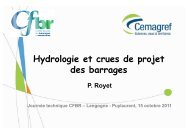SMALL DAMS
SMALL DAMS - Comité Français des Barrages et Réservoirs
SMALL DAMS - Comité Français des Barrages et Réservoirs
- No tags were found...
You also want an ePaper? Increase the reach of your titles
YUMPU automatically turns print PDFs into web optimized ePapers that Google loves.
G eological and geotechnical studies<br />
Final report<br />
The final report is drafted after all the preceding stages have been completed and<br />
includes:<br />
!" a summary of all the geological studies done since the beginning;<br />
!" the geotechnical summary mentioned above (preliminary geotechnical study);<br />
!"definition of investigations for the tender design stage (core sampling, undisturbed<br />
or remoulded samples, geophysical tests, geotechnical tests in a laboratory and in<br />
situ, etc.);<br />
!" supporting arguments for the type of dam recommended as the most suitable for<br />
the site;<br />
!" a preliminary sketch of the dam (zoning, slopes, cutoff trench excavations, etc.)<br />
and an opinion on foundation treatment and if necessary treatment of the reservoir<br />
basin.<br />
GEOLOGICAL AND GEOTECHNICAL STUDIES IN THE TENDER DESIGN STAGE<br />
For most small dams, this phase is combined with the preliminary design phase.<br />
60<br />
Objective<br />
Except in special cases, geological aspects are familiar at this point, and only extremely<br />
localised site investigations will generally be necessary (in particular on foundations<br />
of ancillary works such as the spillway, outlet tunnels, diversion tunnels, inspection<br />
adits, intake tower, secondary dams if they were not considered in the preliminary<br />
design).<br />
However, if there is any significant change in the dam layout (or just the axis of the<br />
watertight system) since the preliminary design site investigations, new core sampling<br />
and water tests will be necessary on the new layout.<br />
On the other hand, in this stage of study most of the geotechnical studies proper (soil<br />
and rock mechanics according to the case) are necessary:<br />
!" taking samples in numbers suited to the size of the dam and the conditions<br />
encountered (geological complexity and variability of the soils), in the foundation<br />
and in the planned borrow areas;<br />
!"laboratory tests (with a schedule tailored to give good knowledge of the foundation<br />
for the structures and the borrow areas). Their purpose is to give the designer the<br />
necessary elements for tender design of the dam and to enable recommendations to<br />
be made on geological and geotechnical aspects during the works and later monitoring<br />
of the dam throughout its life. In France this stage of study for dams 20 metres<br />
high or higher corresponds to the final brief that must be submitted to the Permanent<br />
Technical Committee on Dams.


